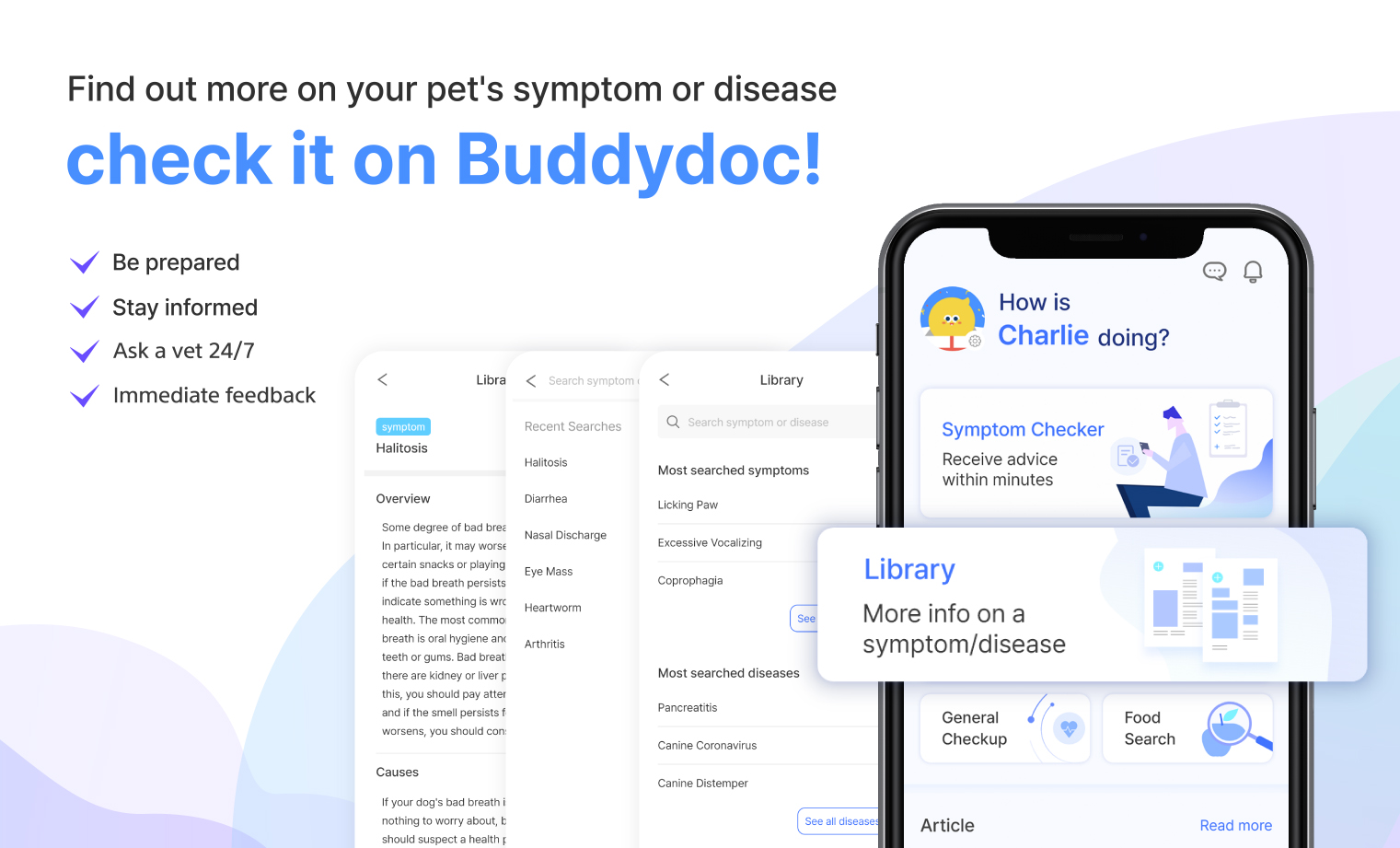DISEASES
Ventricular Septal Defect (VSD) in Dogs - Symptoms and Treatments
페이지 정보
본문


What is Ventricular Septal Defect (VSD) in dogs?
Ventricular septal defect (VSD) is a rare congenital disorder in which there is a hole in the septum located between the left and right ventricles of the heart. This hole allows blood to flow between the ventricles, rather than remaining separate as it should. This can cause blood to flow in the wrong direction and increase the amount of blood in pulmonary circulation, leading to volume overload on the left side of the heart. If left untreated, the condition can lead to the development of pulmonary hypertension and, eventually, right heart failure.
Most instances of VSD occur within the aortic valve or tricuspid valve. The progression of this disease can vary depending on the size of the defect and the presence of other congenital heart diseases, such as subaortic stenosis.
Treatment for VSD depends on the severity of symptoms and the direction of blood flow and may include medication to manage heart function and symptoms, as well as surgery or interventional therapy to correct the defect.
Common causes of Ventricular Septal Defect (VSD) in dogs
There is evidence that a ventricular septal defect in dogs occurs more commonly in some breeds than others. However, the exact cause has not been identified yet.
This condition has been reported more in the following breeds:
- Keeshonds
- English/French Bulldogs
- Akitas
- Basset Hounds
- English Springer Spaniels
- German Shepherds
- Lakeland Terriers
- Old English Sheepdogs
- West Highland White Terriers
Symptoms of Ventricular Septal Defect (VSD) in dogs
Symptoms of canine ventricular septal defect may vary depending on the size of the defect and the direction of blood flow. If the defect is small, there are typically no symptoms. However, if the defect is large enough, left congestive heart failure may cause symptoms such as fatigue, exercise intolerance, coughing, and fainting. In cases where the ventricular septal defect has progressed for a prolonged period and pulmonary hypertension is present, symptoms such as cyanosis and dyspnea may occur.
You may notice some of the following symptoms common with VSD in dogs and puppies:
- Lethargy
- Exercise intolerance
- Decreased appetite
- Coughing
- Weight loss
- Severe panting
- Pale gums
- Increased heart rate
- Fainting
Risk of the Ventricular Septal Defect (VSD) in dogs and when to see a vet
If your dog experiences symptoms such as rapid fatigue, exercise intolerance, coughing, or fainting during exercise, play, or excited situations. It is recommended that you visit a hospital for an accurate examination, as there is a possibility of another heart disease in addition to a septal defect. In any case, if you experience breathing difficulties or cyanosis, you should visit the hospital immediately.
Can you treat Ventricular Septal Defect (VSD) in dogs at home?
Ventricular septal defect (VSD) in dogs is a disease that requires specialized treatment in a hospital setting. If the symptoms of VSD appear, it is important to limit your dog's exercise and play and avoid situations that may excite them. It is also crucial to visit a hospital as soon as possible to receive an accurate diagnosis and start treatment early.

How Ventricular Septal Defect (VSD) in dogs is diagnosed at the vet
If a heart disease is suspected, the veterinarian will make a diagnosis through the following process.
-
Physical examination
During the physical examination, a thorough discussion of any history of heart disease and related symptoms will be conducted. Auscultation, which involves listening to the heart with a stethoscope, is an important step in the examination. In many cases of heart disease, a murmur or arrhythmia may be detected during this initial examination.
-
X-rays
If there are symptoms such as coughing and shortness of breath, an X-ray test can be performed to differentiate the several different causes. There are possibilities of other respiratory diseases that can cause similar symptoms besides heart disease. A chest radiograph can help rule those causes out and also evaluate the size of the heart. Ventricular septal defects may initially enlarge the left side of the heart, and as the disease progresses, pulmonary hypertension may develop, causing the right ventricle to enlarge as right heart failure develops.
-
Electrocardiogram (ECG)
An electrocardiogram is an evaluation of the electrical activity of the heart. It is performed by attaching electrodes to the body and is used to determine the presence and type of arrhythmia. In cases of ventricular septal defect, evidence of an enlarged left ventricle and left atrium, such as a widened P-wave and a high R-wave, can be observed on the electrocardiogram.
-
Echocardiography
The most useful method for diagnosing heart disease is understanding the structure inside the heart. Through echocardiography, it is possible to evaluate various structures and functions of the heart, such as the presence and degree of stenosis, the pattern of blood flow, velocity, and pressure difference, and the thickness of the myocardial wall.
Defects in the ventricular septum can be observed by monitoring blood flow. It is possible to determine whether blood is flowing from the left ventricle to the right ventricle or from the right ventricle to the left ventricle at the site of the defect and to assess the velocity and presence of pulmonary hypertension.
-
Blood test
In general, blood tests such as complete blood count and serum biochemistry are used to evaluate possible side effects of medications for prescribing after diagnosing heart disease and to evaluate the overall condition of the body.
Although not often used, depending on the situation, biomarkers that can detect changes in the presence of heart diseases, such as proBNP or Troponin I, may be used for testing.
How Ventricular Septal Defect (VSD) in dogs is treated at the vet
Depending on the severity and progression of ventricular septal defect in a dog, various treatments can be performed to help correct the defect.
-
Movement restrictions
To minimize the workload of the heart, it is necessary to limit movement and manage your pet’s mood not to get too excited.
-
Medication
Drug treatment is usually aimed at relieving the symptoms it causes and preventing them from getting worse, rather than treating the ventricular septal defect itself. If congestive heart failure develops from a ventricular septal defect, drugs such as diuretics can reduce fluid retention in the heart or lungs.
-
Interventional procedures and surgical procedures
Various surgical techniques such as pulmonary banding or open heart surgery can be used to fundamentally resolve pulmonary artery stenosis.
A surgical technique, such as the Amplatzer septal occlude, can be used to close the defect by passing it through the blood vessels to the heart.
There are not many places where these procedures or surgeries can be performed, so a specialist consultation is required.
Canine Ventricular Septal Defect treatment prognosis
Ventricular septal defect (VSD) is an uncommon condition that rarely progresses to the point of requiring procedures or surgery. As a result, the prognosis for patients can vary. The prognosis for VSD depends on several factors, including the size of the defect, the patient's response to medication, the surgical method used, and the success of the procedure. In general, the prognosis is good for patients with small defects, but it may be poor for those with larger defects.
Prevention of Ventricular Septal Defect (VSD) in dogs
Since ventricular septal defect is a congenital disease present from birth, it is not possible to prevent it. Early detection and management through regular examinations is the best approach. If your dog or its parents have a ventricular septal defect, it is recommended to avoid breeding to prevent passing it on to offspring.
Find out more about your dog’s VSD symptoms on the Buddydoc app!

The Buddydoc library is filled with everything you’d want to know about each symptom and disease your pet may experience. If you would like to find out more about the causes, signs, treatments, preventions, and more for your dog’s disease. Try out the Buddydoc app and search your pet’s symptom or disease in the Buddydoc library.












